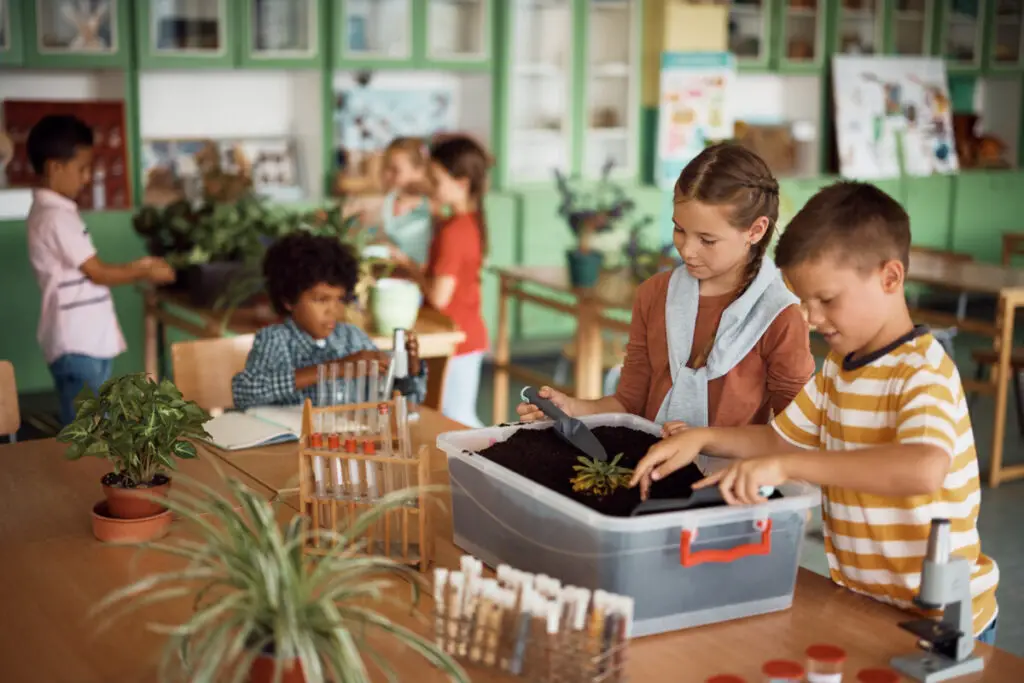Is your child curious about the world around them? Do you want to raise a leader who cares about the environment? Is your child fascinated by watching butterflies flit between flowers? Do you want to raise a leader who can make a real difference in the fight for a healthier planet?
Look no further than the engaging read of the plant life cycle! It’s not just about memorizing boring terms – it’s about unlocking a secret world where a tiny seed transforms into a towering tree, teeming with life.
Embark on an immersive journey through the fascinating world of the plant life cycle, where young minds delve into engaging activities meticulously crafted to ignite creativity and instill vital STEM (Science, Technology, Engineering, and Mathematics) principles.
As your child explores the different stages of a plant’s life, they’ll not only gain a deeper understanding of science and biology but also develop essential life skills like teamwork, critical thinking, and environmental responsibility.
Here’s why plant power is the secret weapon for eco-leaders:
- Leadership & Teamwork: Working together to plant seeds and nurture seedlings teaches valuable collaboration skills. Your child will become a team player who tackles environmental challenges head-on!
- Civic Responsibility: Understanding how plants sustain life fosters a sense of responsibility for our planet. Your child will become an advocate for a greener future
Read on to discover how exploring the plant life cycle can transform your child’s perspective and empower them to make a positive impact on the world!
Table of Content
- Understanding the Plant Life Cycle
- Integration of Plant Life Cycle Learning
- Sustainability and Environmental Awareness
- Incorporating Technology and Innovation
- Cultivating Lifelong Love for Learning
- Conclusion
Understanding the Plant Life Cycle
Effective understanding of the plant life cycle requires careful observation and exploration of each stage. Each stage plays a crucial role in the growth and development of plants, and by understanding these stages, your child can appreciate the resilience and adaptability of the plant kingdom.
Seed Germination and Growth
The Magic of Sprouting: Understanding the process of seed germination is essential. Seeds require the right combination of moisture, warmth, and oxygen to sprout. Kids can create mini-experiments to observe how different conditions affect germination rates.
For example, they can plant seeds in different containers with varying levels of moisture or sunlight exposure, recording their observations and drawing conclusions.
From Seed to Seedling: As seeds germinate, they develop into seedlings, which eventually grow into mature plants. Learning about the different parts of a plant, such as roots, stems, leaves, and flowers, helps kids understand the functions of each part and how they contribute to plant growth.
Activities like creating labeled plant diagrams or dissecting (with adult supervision) a flower can make learning about plant anatomy fun and engaging.
Reproduction and Pollination
The Dance of the Pollinators: Exploring the process of reproduction in plants involves learning about pollination and fertilization. Kids can observe how insects, birds, and even wind play a crucial role in transferring pollen between flowers, leading to the formation of seeds.
This is a great opportunity to discuss the interconnectedness of living organisms in ecosystems – plants rely on animals for pollination, while animals depend on plants for food and shelter. Encourage your child to create a “pollinator garden” by planting flowers that attract bees, butterflies, and hummingbirds.
Seed Dispersal and Renewal
Nature’s Travel Agents: Observing seed dispersal mechanisms is another fascinating aspect of the plant life cycle. Kids can explore how seeds are dispersed by wind (think dandelions), water (like coconuts), animals (squirrels love burying acorns), or even explosive fruits (think squirting cucumbers).
Learning about these diverse strategies helps kids appreciate the resilience and adaptability of plants in different environments. They can create a chart or collage depicting the different ways seeds travel and discuss the importance of seed dispersal for ensuring the survival and renewal of plant populations.
Integration of Plant Life Cycle Learning in Education

Exploring the plant life cycle offers numerous opportunities for integrating hands-on learning in educational settings. Teachers can incorporate interactive activities and outdoor experiences to enhance students’ understanding of science and biology.
Experiential Learning
- Planting the Seeds of Knowledge: Hands-on activities such as planting seeds in a classroom garden, maintaining a terrarium, or observing plant growth in a window box provide valuable learning experiences. Kids can actively participate in every stage of the plant life cycle, from carefully selecting seeds and preparing the soil to nurturing seedlings, monitoring growth, and harvesting fruits or vegetables. This fosters a sense of ownership and responsibility for the well-being of their plants, while allowing them to witness firsthand the fascinating transformation that occurs.
- Beyond the Classroom Walls: Outdoor field trips to botanical gardens, nature reserves, or local parks offer opportunities for real-world exploration and observation. Immersing students in diverse plant ecosystems allows them to interact with a variety of plant species and observe how plants adapt to different environments. They can compare and contrast different plant structures, identify local flora, and learn about the vital role plants play in supporting animal life and maintaining healthy ecosystems.
- Citizen Science in Action: Engaging students in citizen science projects allows them to contribute valuable data to real-world research initiatives. For example, they can participate in seed dispersal studies by collecting and analyzing fallen seeds, or monitor local butterfly populations to understand the importance of pollinators. Citizen science projects provide a powerful way for students to connect classroom learning to environmental issues and feel empowered to make a positive impact.
By incorporating these experiential learning approaches, teachers can transform the exploration of the plant life cycle into an engaging and enriching educational experience that goes far beyond rote memorization. Students become active participants in their own learning, developing critical thinking skills, fostering a connection with the natural world, and cultivating a sense of environmental responsibility.
Integrating plant life cycle learning across various subjects enhances students’ holistic understanding of science and its interconnectedness with other disciplines. Teachers can incorporate elements of math, language arts, and environmental studies into plant-related activities, promoting interdisciplinary learning.
Sustainability and Environmental Awareness
Exploring the plant life cycle provides opportunities for fostering environmental awareness and promoting sustainable practices. Kids can learn about the importance of preserving ecosystems and reducing their ecological footprint.
Hands-On Conservation Projects
Engaging in hands-on conservation projects, such as planting native species or creating habitat gardens, empowers kids to make a positive impact on their environment. They can learn about the importance of biodiversity and the role of plants in supporting healthy ecosystems.
Through experiential learning, kids develop a sense of environmental stewardship and responsibility towards protecting natural resources. They can explore sustainable gardening practices, such as composting, water conservation, and organic gardening methods.
Community Engagement and Advocacy
Encouraging community engagement and advocacy initiatives empowers kids to become environmental leaders in their communities. They can participate in local gardening clubs, tree planting events, or environmental cleanup activities, promoting environmental awareness and action.
By actively participating in environmental projects, kids develop a sense of agency and responsibility towards creating a more sustainable future for generations to come.
By actively participating in environmental projects, children not only develop a deeper connection to their surroundings but also cultivate essential leadership skills and a sense of civic responsibility.
Moreover, the exploration of the plant life cycle serves as a catalyst for fostering collaboration and community engagement. Through collaborative endeavors, children learn the value of teamwork and collective action in addressing environmental challenges.
By working together towards common goals, they develop empathy, communication skills, and a shared commitment to making a positive difference in the world.
Incorporating Technology and Innovation
Harnessing the power of technology and innovation enhances the exploration of the plant life cycle, offering new avenues for learning and discovery. Interactive digital resources, virtual field trips, and educational apps provide immersive experiences, allowing children to explore the complexities of plant biology in a dynamic and engaging manner.
From virtual plant dissections to simulated growth simulations, technology opens doors to endless possibilities for exploration and experimentation. Moreover, embracing innovative technologies such as hydroponics and vertical farming introduces children to cutting-edge agricultural practices, highlighting the role of science and technology in addressing global food security challenges.
Through hands-on experimentation with hydroponic systems and vertical gardens, children gain practical insights into sustainable agriculture and resource management, empowering them to become informed stewards of the environment.
Cultivating Lifelong Love for Learning
Ultimately, the exploration of the plant life cycle lays the foundation for a lifelong love for learning and a deep appreciation for the natural world.
By nurturing curiosity, critical thinking, and environmental consciousness, children embark on a transformative educational journey that transcends the classroom walls.
Armed with knowledge, empathy, and a sense of purpose, they are empowered to become agents of positive change in their communities and stewards of the planet.
Conclusion
In conclusion, the exploration of the plant life cycle offers a rich tapestry of learning experiences that ignite curiosity, foster creativity, and instill essential STEM principles in children. Through hands-on exploration, interdisciplinary connections, and community engagement, children embark on a transformative educational odyssey that nurtures a profound understanding of nature and cultivates a sense of responsibility towards the environment!



Hello! I’ve been reading your web site foor a while now and finally got the bravery to go ahead and gve you a shout out from Kingwood Tx!
Just wanted to say keep up the good job! https://Www.Waste-Ndc.pro/community/profile/tressa79906983/
Wow, a shout-out from Kingwood, TX? That’s awesome! So glad you finally decided to say hi! Thanks for keeping up with the blog, and we’re happy you’re enjoying it. Your message truly made my day. Again, if there is something that you would like for us to discuss, please let us know.
Hi there, after reading this awesome post i
am too happy to share my experience here with friends. https://Www.Waste-Ndc.pro/community/profile/tressa79906983/